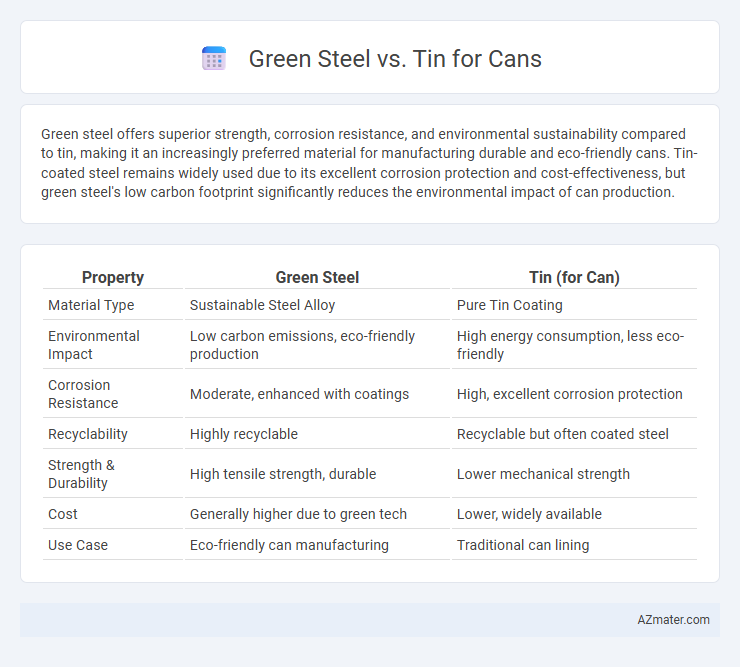Green steel offers superior strength, corrosion resistance, and environmental sustainability compared to tin, making it an increasingly preferred material for manufacturing durable and eco-friendly cans. Tin-coated steel remains widely used due to its excellent corrosion protection and cost-effectiveness, but green steel's low carbon footprint significantly reduces the environmental impact of can production.
Table of Comparison
| Property | Green Steel | Tin (for Can) |
|---|---|---|
| Material Type | Sustainable Steel Alloy | Pure Tin Coating |
| Environmental Impact | Low carbon emissions, eco-friendly production | High energy consumption, less eco-friendly |
| Corrosion Resistance | Moderate, enhanced with coatings | High, excellent corrosion protection |
| Recyclability | Highly recyclable | Recyclable but often coated steel |
| Strength & Durability | High tensile strength, durable | Lower mechanical strength |
| Cost | Generally higher due to green tech | Lower, widely available |
| Use Case | Eco-friendly can manufacturing | Traditional can lining |
Introduction to Green Steel and Tin in Can Production
Green steel, produced using low-carbon technologies such as hydrogen-based reduction and electric arc furnaces, offers a sustainable alternative to traditional steel by significantly reducing CO2 emissions. Tin, primarily used as a coating in can production, provides corrosion resistance and preserves the integrity of food and beverage containers. The integration of green steel in can manufacturing promises enhanced environmental benefits while maintaining the protective qualities essential in tin-coated cans.
Environmental Impact: Green Steel vs Tin
Green steel significantly reduces carbon emissions by using hydrogen or electric arc furnaces instead of traditional coal-based methods, minimizing its environmental footprint compared to tin production. Tin extraction involves intensive mining processes that can lead to habitat destruction, soil degradation, and hazardous waste generation, posing greater ecological risks than green steel manufacturing. Lifecycle assessments show green steel's potential for sustainable scalability in packaging, offering a lower impact alternative to conventional tin cans.
Material Properties: Strength and Durability
Green steel exhibits superior strength and durability compared to tin, making it an ideal material for can manufacturing. Its high tensile strength and resistance to corrosion ensure longer-lasting and more robust cans, reducing the risk of deformation or damage during transport and storage. In contrast, tin, though lightweight and malleable, offers lower mechanical strength and is more prone to denting and degradation over time.
Manufacturing Process and Energy Consumption
Green steel production involves using hydrogen-based direct reduction and electric arc furnaces powered by renewable energy, significantly lowering carbon emissions compared to traditional blast furnaces. Tin manufacturing for cans relies on smelting and electroplating processes that consume substantial electricity and release greenhouse gases, though on a smaller scale relative to steel production. Energy consumption in green steel is higher initially due to the use of advanced technology but results in greater long-term sustainability compared to tin plating methods.
Cost Comparison: Green Steel vs Tin Cans
Green steel production currently incurs higher costs compared to traditional tin, largely due to its reliance on emerging clean technologies such as hydrogen-based reduction methods. Tin, widely used in can manufacturing, remains cost-effective due to established supply chains and lower energy requirements for production. Despite the initial expense, green steel offers long-term economic advantages through reduced carbon taxes and alignment with stricter environmental regulations.
Recyclability and Resource Efficiency
Green steel offers superior recyclability with a well-established closed-loop cycle, enabling multiple reuses without degradation of quality, unlike tin, which typically undergoes limited recycling due to contaminant buildup. The production of green steel incorporates renewable energy and hydrogen, significantly reducing carbon emissions and enhancing resource efficiency compared to traditional tin extraction and smelting. As a result, green steel is becoming a preferred material for cans due to its lower environmental footprint and sustainable lifecycle management.
Market Trends and Industry Adoption
Green steel is rapidly gaining traction in the can manufacturing industry due to its lower carbon footprint and sustainability advantages, attracting investments from major packaging companies aiming to meet regulatory and consumer demand for eco-friendly products. The tin can market, historically dominant, faces pressure as green steel offers comparable durability with significantly reduced environmental impact, driving a gradual shift in industry adoption patterns. Market trends indicate increasing collaboration between steel producers and can manufacturers to scale green steel production, reflecting a strategic move toward decarbonization and circular economy goals in the packaging sector.
Health and Safety Considerations
Green steel used in can manufacturing offers significant health and safety advantages due to its reduced reliance on toxic chemicals and lower emissions during production compared to traditional tin plating processes. Tin, while providing corrosion resistance, can sometimes pose concerns related to tin migration into food products, especially if coatings degrade, potentially affecting consumer health. Utilizing green steel not only minimizes environmental impact but also reduces the risk of contaminant exposure, thereby enhancing safety standards in food packaging applications.
Challenges in Transitioning to Green Steel
Transitioning from tin to green steel for can manufacturing presents significant challenges, including higher production costs driven by the energy-intensive processes of green steel derived from hydrogen or renewable electric arc furnaces. Limited scalability and supply chain constraints hinder widespread adoption, as green steel production capacity currently lags behind demand for can-grade materials. Furthermore, technical obstacles exist in ensuring green steel matches the corrosion resistance and malleability properties of traditional tin, affecting the durability and safety of food and beverage cans.
Future Outlook for Sustainable Can Packaging
Green steel promises a transformative impact on sustainable can packaging by significantly reducing carbon emissions compared to traditional steel production methods. Innovations in renewable energy integration and hydrogen-based steelmaking are expected to drive widespread adoption, enhancing the environmental profile of metal cans. Tin, while essential for corrosion resistance in can linings, faces sustainability challenges due to limited reserves and environmentally intensive mining, prompting research into alternative coatings and recycling improvements to align with future eco-friendly packaging goals.

Infographic: Green steel vs Tin for Can
 azmater.com
azmater.com